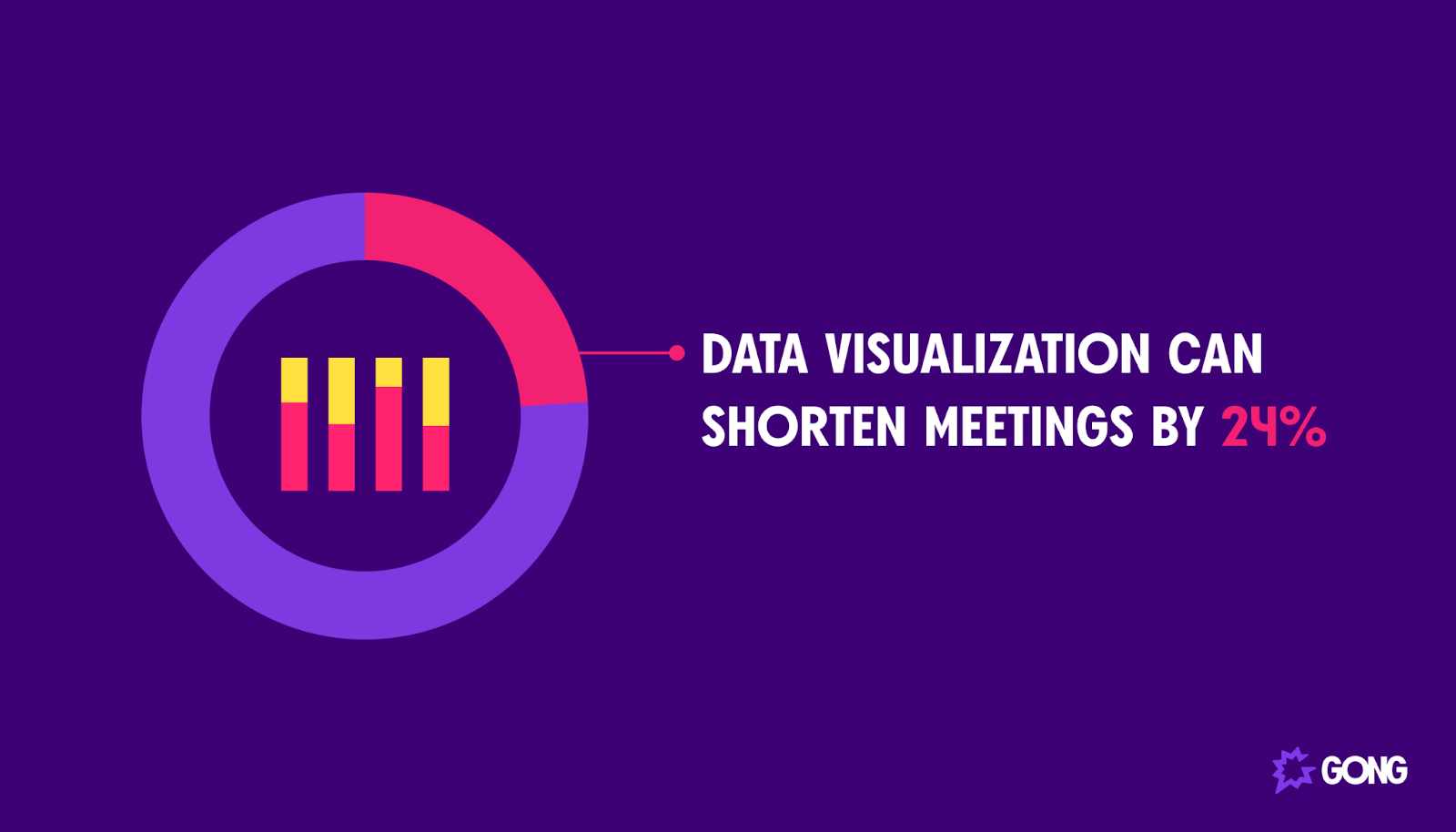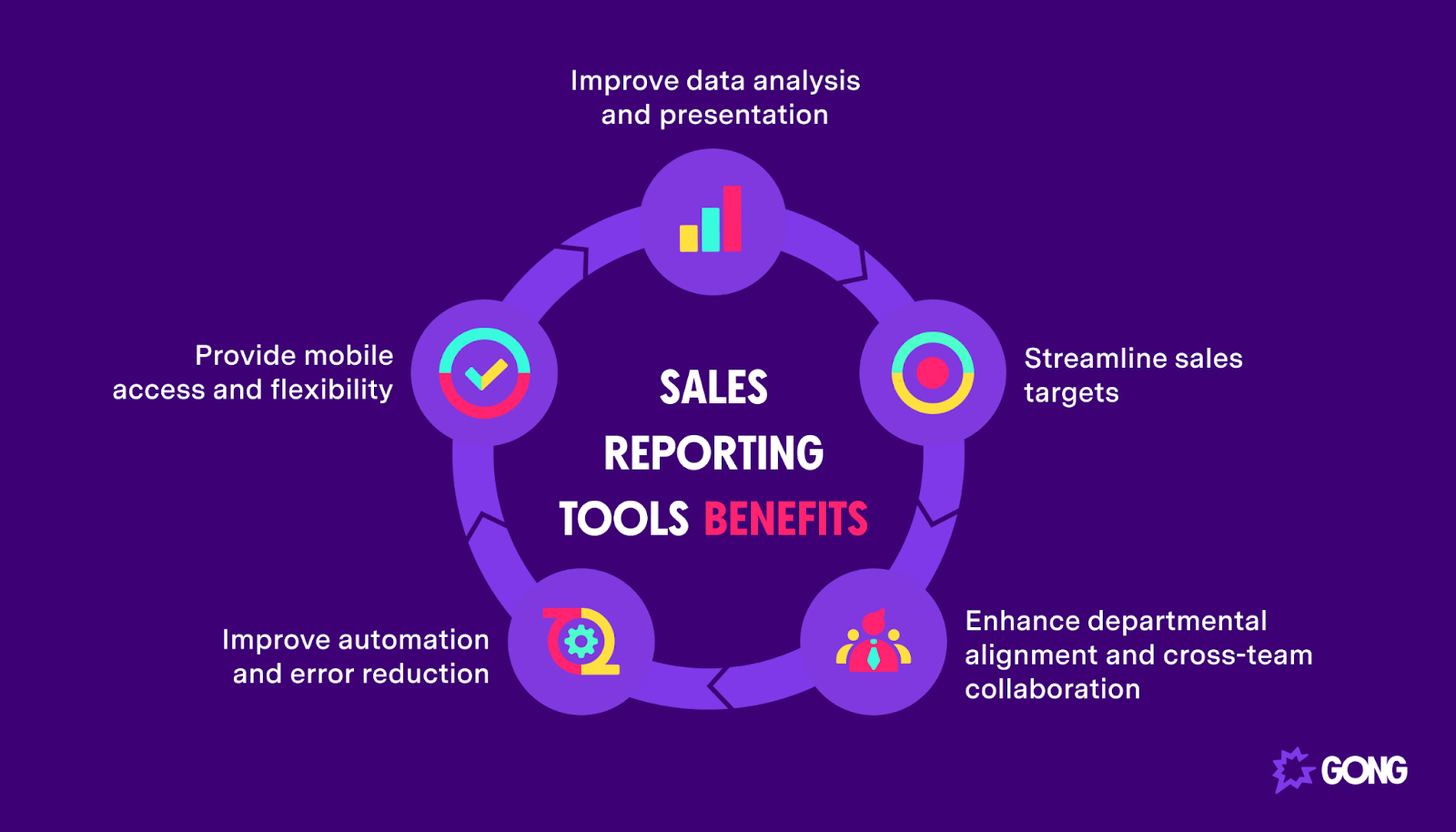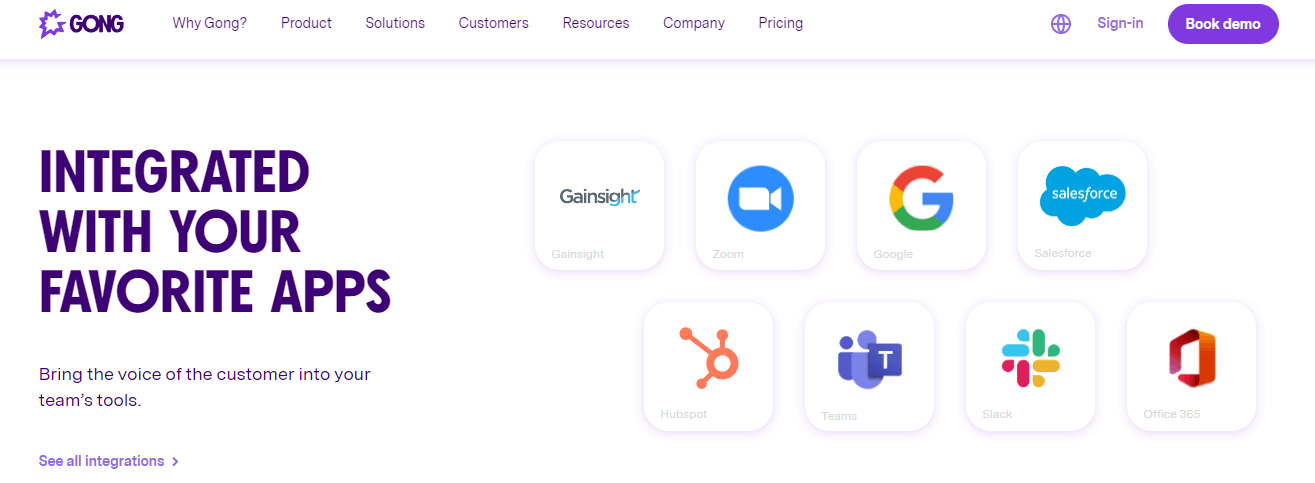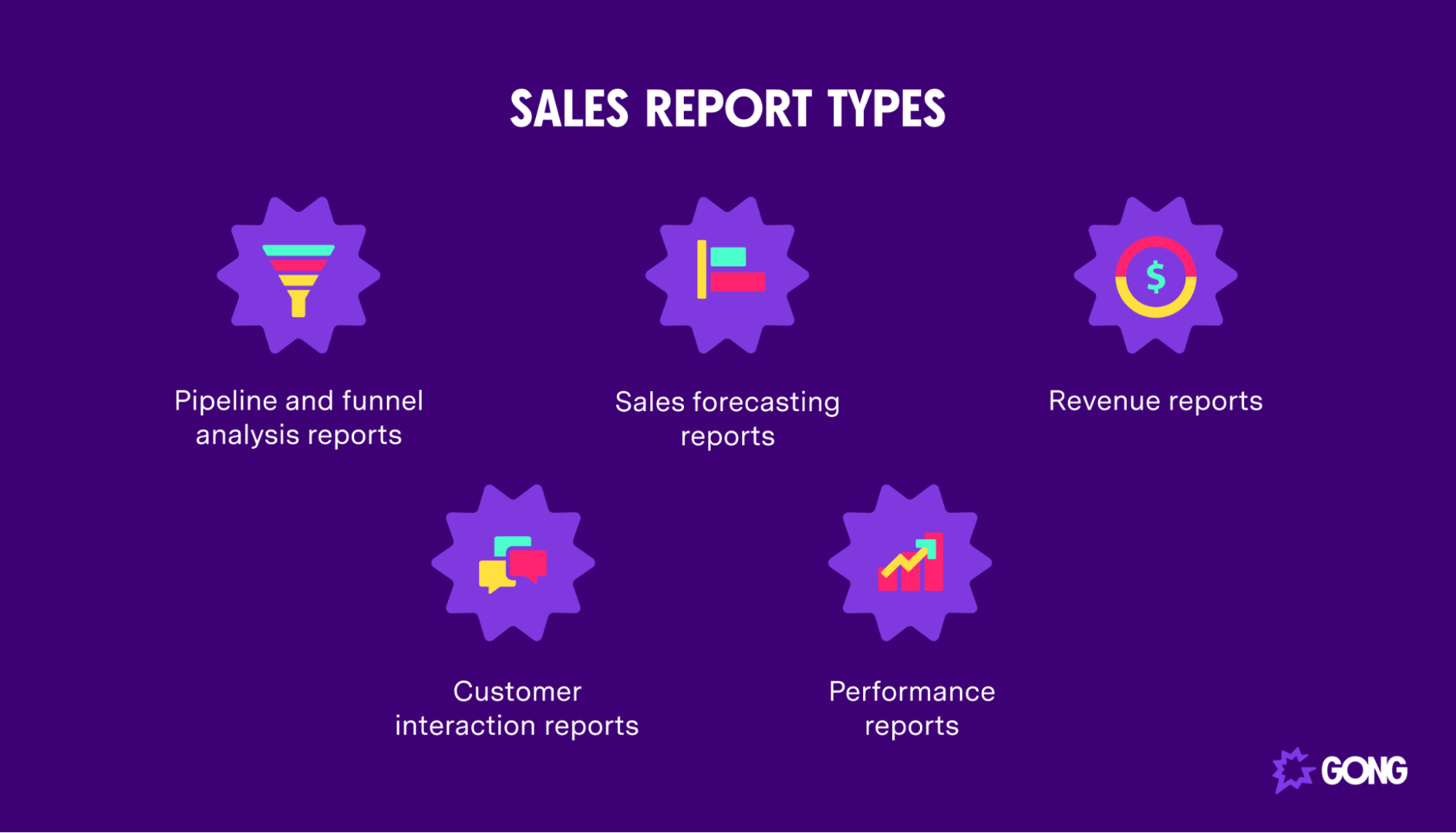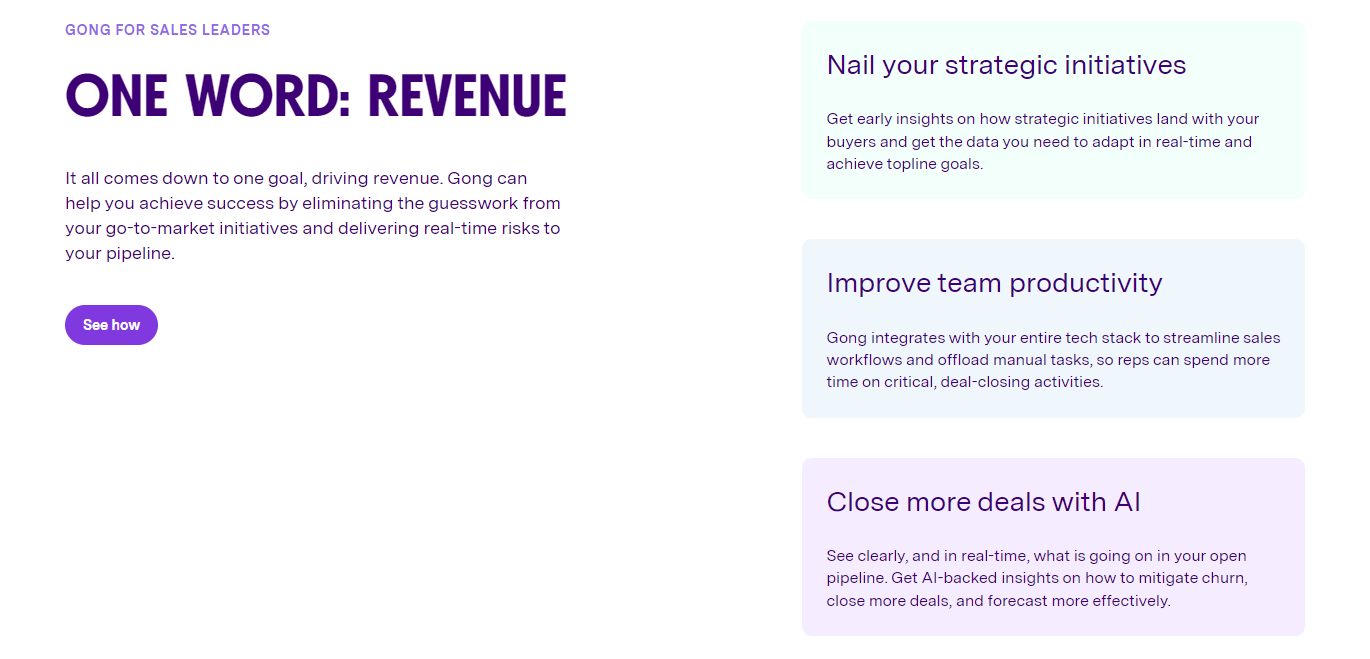Choosing the best sales reporting software for your company
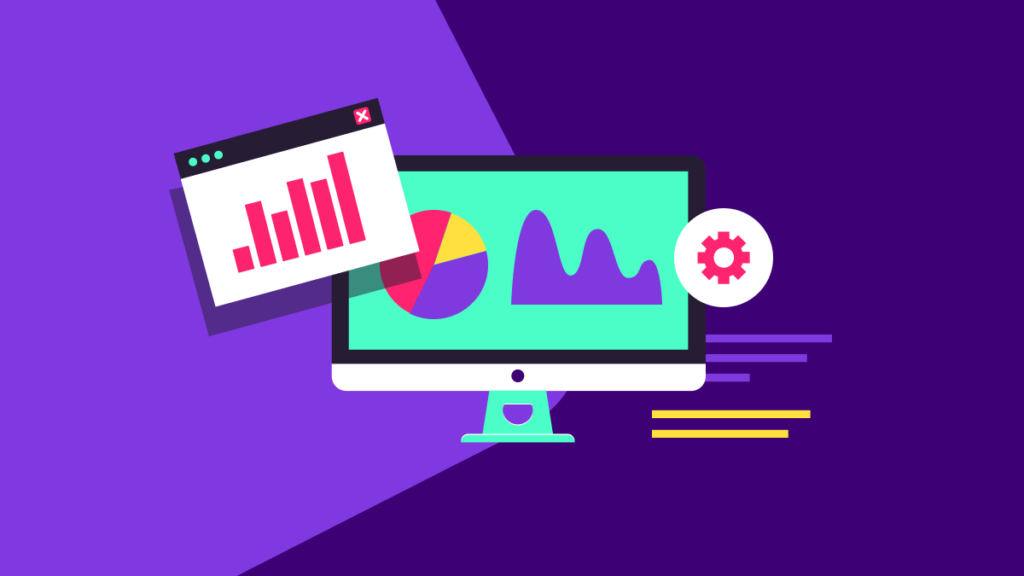
RevOps teams agree: Relying on traditional sales reports has serious consequences for profitability.
When sales professionals are waylaid by non-essential activities that machines can expedite, you have to wonder why sales reps spend time like this:
- 72% of their weekly work hours go into non-selling activities
- 8.8% of their time goes to administrative tasks
- Almost 10% of their day is spent entering customer and sales information
The good news is that sales reporting software can reduce (and, in many cases, entirely eliminate) these numbers by offering sales teams better workflows. It provides them with better customer interaction data, more accurate predictions, automation, and AI-powered insights to totally transform their ability to make data-driven decisions.
This capability comes with a note of caution: Because sales reporting — as a growth-related activity — is so central to the RevOps playbook, it’s more important than ever to ensure that the software solution you choose will simplify your workflows, rather than add complexity to them.
Follow along below as we investigate the ins and outs of sales reporting software, the outcomes you can expect from its implementation, foundational features for your growth goals, and more.
What does sales reporting software do?
Sales reporting software captures and analyzes individual and team sales performance, revealing insights into sales trends, customer and rep behaviors, and purchasing patterns.
A reputable platform will generate analytics reports on key sales metrics, based on the continuous collection of data from sources such as your sales pipeline, CRM, and marketing initiatives like email or ad campaigns.
As part of its basic functionality, sales reporting software automates data collection and translates patterns, trends, and insights using compelling visuals that make it easy to identify gaps, back up pitches with data, and better forecast budget and resource allocations for the year.
And that’s just its core function. Great sales reporting software can change the way teams work, communicate, and collaborate, both internally and in customer-facing situations.
Here’s a sampling of what it can do:
- With automated and customizable reports that present insights visually, meetings are 24% shorter, and significantly reduce a sales team’s workload.
- An AI-integrated sales reporting solution helps future-proof your sales and RevOps with real-time information about emerging patterns and predictions about how those will affect future sales. This allows sales teams to better prepare for upcoming demand or optimize their sales funnel to align with customers’ purchasing patterns.
- The software can facilitate collaboration between sales and other departments through shareable and custom dashboards that keep everyone on the same page.
If there’s one objective you should set when adopting sales reporting software, it’s the ability to decode sales by converting raw data into actionable insights. This is true whether you target enterprise companies or SMBs.
Enterprise sales do have large contracts with a necessarily longer deal cycle, simply due to the number of stakeholders involved in the purchase decision. The right sales reporting platform should be able to “decode” where gaps occur, even in these long sales cycles.
Meanwhile, SMB sales tend to have fewer decision-makers and shorter deal cycles but also come with tighter budgets. They’re often more discerning with their purchase decisions. Your sales reporting platform should reflect this tendency and draw conclusions accordingly, so your team can act on them.
Why are sales reporting tools essential?
Ultimately, the right sales reporting platform should empower sales reps to sell more easily and effectively.
Here are the top five ways sales reporting software helps you and your team get there:
#1: Improve data analysis and presentation
As your business scales, its data volume grows in tandem — and that data will be prone to errors if you rely on reps for data entry and updating.
In contrast, a sales reporting tool automatically captures data from multiple sources, to uncover the most granular insights and provide high-quality analysis.
Once you have the capacity to generate accurate data and insights, you want teams to be able to access and understand them easily. That’s why your software solution needs to simplify data interpretation and make even technical reports digestible for every stakeholder.
Quality reporting systems present findings through compelling graphs and visuals that marketing professionals, sales reps, and customer support team members can view at a glance.
This effective data analysis and presentation will enable data-driven decision-making across your revenue organization.
#2: Streamline a path to closed-won
Setting and tracking sales targets manually for a growing team is inefficient — and sales reporting tools can solve this problem. You can set targets for each sales rep based on forecasting data, trends, and their bandwidth.
You should be able to easily generate reports that offer transparency into performance metrics and encourage self-evaluation and improvement.
Managers can easily keep track of their team’s performance in real time, in custom dashboards.
Data captured by sales reporting software should enable sales team leaders to uncover individual strengths and weaknesses, plan professional development opportunities, and tailor coaching scripts for sales calls.
Some sales reporting software offers actionable insights and coaching recommendations to improve your bottom line and quickly reach targets.
#3: Enhance departmental alignment and cross-team collaboration
Every strategic initiative you launch is unique, and marketing and sales must be perfectly aligned to drive quality leads into your pipeline. That requires seamless communication and streamlined collaboration among departments.
A sales reporting tool can help establish communication channels and a collaboration framework. In it, teams can share updates and insights and enrich their joint understanding of customers’ needs and how to cater to them. With customer information organized in a unified platform, everyone has the same information, which enables collaborative decision-making.
Sales reporting software lets employees easily message each other and comment on collaborative projects. The system sends real-time notifications so others can take note of relevant changes and implement revised strategies quickly.
Collaborative features let departments communicate clearly and easily by facilitating trust, encouraging teamwork, and making employees adept at working toward shared goals.
#4: Reduce or eliminate human error
Manual processes leave a lot of room for error. Reps may miss important details about a potential customer that may affect sales negatively.
Additionally, repetitive tasks like data entry and lead scoring take up significant time your team could invest in strategizing sales outreach and other sales-related tasks.
A sales reporting platform can help you bypass these roadblocks with smart automation. This software can pull data directly from your CRM and ERP systems, ensuring that nothing slips through the cracks.
It’s designed to organize data and generate automated reports in a consistent and accessible format so there are no discrepancies — or very few — from inconsistent data handling.
These sales tracking solutions are designed with consistent data validation rules, flag potential anomalies, and ensure data accuracy. That’s why their generated reports are more precise, insightful, and actionable.
#5: Provide mobile access and flexibility
Besides automation and collaboration, effective sales tracking software offers mobile access to reports. Your sales team can access insights and previous interactions wherever they are, and follow up with potential customers.
Whether your team is on site or on the move, they can brush up on their clients’ needs and provide the best possible experience. You’ll see increased flexibility and improved responsiveness across your revenue teams.
To experience these five benefits, you’ll need to ensure that you’re working with the right sales reporting software. Next up, we’ll consider 10 essential features that are foundational to your business’s revenue goals.
10 core features of good sales reporting software
After almost two decades of increasingly sophisticated software platforms, there’s now a baseline level of features and functions that all analytics software offer. But you’re looking for one that’s capable of reporting on the full sales funnel, from lead to close.
Here are the essential sales reporting features you should look for when choosing sales analytics software:
1. Ability to generate simple, accurate, and comprehensive reports
Your chosen sales reporting platform must produce clear, comprehensive, and detailed reports. It should present visually clear data that sales reps can refer to quickly between sales calls.
You should be able to create precise reports around every variable related to your entire sales cycle. The insights should cover customer behavior, pipeline analysis, sales funnel health, etc. The tool must be customizable enough to accommodate important sales metrics like:
- Lead generation rate
- Response time
- Conversion rate
- Sales cycle length
- Sales growth
Finally, ensure that your sales tracking tool lets you accommodate KPIs that are unique to your business.
2. Variety of report types
The next feature to check before investing in a sales platform is the range of report types it offers. Your chosen platform should be able to run real-time analytics on individual and team performance, complete with metrics on their progress toward targets.
It should also generate regular sales trends and forecasting reports to help you refine your sales strategy.
An effective sales reporting platform can also create custom reports based on your immediate needs.
3. Automatic data organization
Your chosen software must automatically collect data from multiple sources, validate its accuracy, and organize it in a structured manner.
It must have real-time data sourcing and analytics so you always have the most recent insights and can make decisions that suit changing customer needs. Confirm that you can search for specific insights on the platform using efficient search and filter buttons.
4. Integration with your sales dashboard
The whole point of using tools is to enhance and optimize your pre-existing deal cycles, which are likely supported by other tools. If your sales reps have to go back and forth between multiple platforms, it defeats the purpose of investing in a sales reporting tool.
Your sales reporting software should come with a comprehensive library of available integrations with little-to-no developer input required for connection. Look for support and integrations that cover the most popular CRMs, email marketing tools, and other communication solutions your team uses.
For example, Gong integrates with Google Workspace, Zoom, Salesforce, HubSpot CRM, Slack, and other popular tools.
The software you choose should sync data across platforms automatically to create a single source of truth. That way, your teams won’t have to toggle between tools and can focus squarely on the sales opportunity.
In short, with the right integrations, your sales workflow will be streamlined and agile enough to easily handle a growing customer base.
5. Customizable reporting
Every business is unique, and your chosen sales reporting software must accommodate your specific goals and objectives. Check to see if the software allows ample customization and tailored reports based on your shifting business needs. It should support custom metrics and KPIs so that you can assess the precise areas you want to target.
As your business evolves, your goals will too. Ensure that the sales enablement tools you select can adapt quickly to your changing requirements.
6. Real-time analytics
Effective sales reporting software should offer you real-time analytics and updates. This enables you and your teams to make decisions using current information, thereby reducing errors (and deal losses) caused by outdated or irrelevant data.The software’s real-time analytics feature should also cover sales performance tracking. Sales leaders must have access to every team activity and performance benchmark to drive individual accountability, identify areas of improvement, and enhance productivity.
7. User-friendly interface
Select a sales reporting platform with an easily navigable, user-friendly interface. It paves the way for quick adoption with minimal training and keeps your workflows intact.
An intuitive user experience also helps both seasoned and new employees perform tasks more easily as they can navigate even the most advanced features without wasting time on complicated steps.
Ease-of-use encourages employees to use the system extensively, boosting engagement and productivity.
8. Mobile access
Sales professionals are often on the move while meeting clients, and don’t always have access to their work computers, and others work entirely from remote locations. A sales tool with a mobile application makes everyone’s job easier, giving them access to reports and data insights from anywhere, at any time.
With mobile access to sales reports, your reps can make impromptu but informed decisions during client meetings without returning to the office. Sales leaders can review reports and deliver feedback quickly despite their busy schedules.
This sales reporting feature also allows real-time notifications, keeping every sales rep updated on new leads, customer inquiries, or changes in sales targets. They can respond to urgent customer questions and sales opportunities promptly.
9. Security and compliance
Sales reporting tools must be able to handle large arrays of sensitive customer information. One leak or data breach can harm your reputation and cause expensive legal challenges.
That’s why top-notch data security and compliance is a must-have. Don’t click the “Agree” button under terms and conditions without carefully reviewing its contents. Read each point in detail and find answers to the following questions:
- How does the sales platform handle customer data?
- Does the vendor share the information with any third parties, and to what extent?
- What security measures are in place to safeguard sensitive information?
Understand the current regulations in your industry and assess your chosen tools against those compliance benchmarks.
10. Cross-team collaboration
Collaboration fosters innovation and is proven to increase wins. Invest in sales reporting software that has features like instant messaging and report sharing within teams.
It should also allow collaborative data analysis among stakeholders. Sales managers, team leaders, and other department heads should be able to easily deliver feedback and host discussions on particular data points.
Remember, these 10 essential features are broad guidelines, not hard and fast rules. Look for reporting platforms designed to serve the needs of sales and RevOps teams — including how easy it is to onboard, use, and adopt.
Reps don’t need another solution that’s popular but comes with an overwhelming level of complexity and a steep learning curve. Instead, purchase reporting software that’s built on user experience best practices for sales reps.
What report types should a good sales reporting tool be able to create?
If you ask a sales professional, a sales performance report or a sales forecast is the absolute must-have reporting asset for decisions about how and where the business can expect the greatest ROI. A CRO’s team, on the other hand, is likely to say that it’s lead conversion reports or customer acquisition cost (CAC) reports that should lead the way.
What’s the right answer?
Well, it’s a bit of a trick question because the answer is both.
The various types of sales reports should validate and inform each other and broaden your perspective on RevOps gaps and opportunities. To that end, make sure your software can produce these five types of reporting:
1. Pipeline and funnel analysis reports
Funnel analysis and sales pipeline reports track prospects from initial contact to closing and visualize lead stages. They break down pipeline metrics like response rate, conversion rate, and pipeline health.
You can measure the number of deals in each stage and monitor their progress. The insights let you identify bottlenecks, stages that need more focus, and how to optimize sales processes for better conversion rates.
For example, Gong offers a pipeline management solution with funnel analysis reports that help teams understand sales pipelines inside out. Teams know exactly how deals are progressing and their likelihood of closing.
2. Sales forecasting reports
Forecasting reports predict future sales based on historical data, trends, and ongoing customer interactions. They estimate how much your company will sell in a specific period and predict expected deal closures and performances against targets.
Regular sales forecasting helps you set realistic and achievable sales goals, allocate resources appropriately, and anticipate market changes.
Want sales reporting software that generates accurate sales forecasts? Gong’s AI-powered Forecast solution analyzes past deals and current pipeline data to generate accurate sales forecasting reports.
3. Revenue reports
This type of sales report tracks revenue generated over specific periods, as categorized by products, services, or customer segments. It calculates total sales, growth rate, and revenue contributions by different sources.
Revenue reports help businesses rank revenue streams, identify high-performing products, and eliminate ineffective channels.
Gong’s sales reporting software can also provide revenue analytics, with details about the expected revenue from your current pipeline. You can also monitor your actual revenue against forecasts and test the effectiveness of your sales strategies, processes, and methodologies.
4. Performance reports
Performance reports evaluate the performance of individual sales reps, teams, and departments. They track sales activities, deal closures, quota attainment, and productivity levels.
Performance reports identify strengths and areas for improvement within the team, and help sales leaders notice top performers while allotting projects and leads accordingly.
Gong offers interactive dashboards with deep insights into individual and team performances that highlight training needs and include actionable suggestions.
5. Customer interaction reports
These reports examine your team’s customer interactions, including sales calls, emails, meetings, and other touchpoints. They measure the volume and quality of interactions, engagement levels, and outcomes.
Customer interaction reports help decode customer behaviors, improve communication strategies, and enhance customer relationships.
Thanks to Gong’s extensive integrations, the platform’s analytics can track all your customer interactions and offer actionable insights into your communication and engagement strategies.
You can get a platform tour or book a demo to see it in action.
How do you pick the best sales reporting software for your business?
Features, functionality, customization, scalability, performance — these are all must-haves if you’re going to invest in a technology partner.
But before you begin looking into a potential software partner, clarify the single most pressing reason why you need sales reporting software.
Perhaps you have a specific goal in mind, like hitting a particular market valuation in five years. You’ll need to hit non-negotiable sales targets quarterly and annually, and a sales reporting platform can help you get there. Hitting this valuation goal would be your one driving need.
It may be that your competitors are closing prospects faster with a particular industry or persona. In this case, you’d use your ideal sales software to gather insights from across the deal cycle and uncover bottlenecks and roadblocks. The ideal platform will make this information centrally available, and translate it into actionable next steps that will positively affect revenue.
Overtaking your competitors would be your one driving need in searching for sales reporting software.
Here’s a multi-step process you can reliably use to vet and find “the one”:
Step #1: Understand your team’s needs
While the singular driving need you’ve identified is what your business is aiming at as a whole, the search for the perfect sales reporting software starts with understanding your team’s micro and macro needs.
For example, a sales team operating primarily from an office might have different constraints and requirements than a team that usually holds sales meetings in person. This type of context matters because in-office sales teams may require robust data analytics and CRM integrations, while external or “traveling” sales reps may prioritize mobile access and offline capabilities.
If you have both on your team, your software choice will need to offer features that adequately provide offline mobile access and advanced analytics features.
Step #2: Assess your budget
When you audit your budget don’t leave out these critical steps:
- List the required features and compare plans accordingly.
- Ensure that you evaluate the entire cost, including up-front fees, subscription models, and potential extra charges for updates and add-ons.
- Contact vendors directly to get a custom quote.
Once you have a rough idea about the expense you may incur with each vendor, consider the software’s potential ROI. Will the software save time, increase productivity, and boost sales enough to justify its cost?
Step #3: Evaluate security, privacy, and compliance features
Uphold your customer’s trust by choosing software with impenetrable data security. Ensure that it complies with industry standards and regulations for data security and privacy.
Look for privacy settings like access control, so sensitive information remains among the stakeholders. Evaluate the platform’s data encryption framework to protect critical sales information.
Step #4: Learn about initial and ongoing customer service
Your team may face some hurdles during initial onboarding, implementation, and then once again through adoption. Look into each vendor’s reputation in customer service before investing. Try to understand the following:
- Is the customer support team available 24/7 for the duration of your contract?
- How many channels of contact do they offer? Are they easily accessible?
- Does the vendor offer tutorials, training resources, and manuals?
Step #5: Read customer reviews
Evaluate the vendor’s reputation and market presence. Established vendors with a proven track record are often more reliable. See whether the vendor has a diverse customer base that includes brands you recognize.
Go through reviews and testimonials from other users for authentic insights into the software’s effectiveness. Look for common praises and complaints. Has the vendor taken action to resolve the issues?
You should also check to see whether the software has received any awards or recognition from reputable industry platforms.
For example, among numerous other accolades, Gong was named among the Top 50 Analytics & AI Products by G2 in 2023.
Step #6: Analyze capabilities around your team’s most significant challenges
Using product demos and case studies, you can now make a checklist of the analytical abilities you need in a sales reporting tool, then evaluate potential performance in key categories:
- Analytical and reporting needs: Ensure the software can generate a wide range of report types like pipeline analysis, sales forecasting, revenue tracking, and performance metrics. Prioritize real-time reporting features.
- Customization: Ensure the software lets you create customizable reports tailored to your specific business needs. It should also be agile enough to work with new sales strategies, market conditions, and business objectives.
- Data import and export ease: Assess how well the software imports data from your existing systems and exports reports on command. Does it hamper the integrity and quality of your sales data?
There are more subjective aspects, such as adoption times and the onboarding process, that should factor into your decision-making. Ask your stakeholders to evaluate the following:
- Are the commands and navigation intuitive enough and designed to suit the daily needs of a sales team?
- Is there a significant amount of training or skills uplift that your team will need to go through before being able to use the platform to its fullest potential?
- Does the onboarding process seem clear enough for your team, and do you get a dedicated account specialist?
- Does the vendor offer ample user support on an ongoing basis, such as through a jargon-free knowledge base or help docs?
Step #7: Test-drive the platform during a trial period
Instead of subscribing right away, use the free trial period to get answers to most, if not all, of your questions.
Of course, how the trial goes will depend to some extent on the size and scale of your team, as well as some of the pre-existing workflows you use internally. That’s why it might be beneficial to work with a dedicated account specialist during the trial period.
Regardless, you’re the customer in this scenario, so go ahead and request demos and raise questions specific to your business needs.
Remember, these seven steps will help you narrow down your sales reporting software options and uncover which one responds best to the singular driving need you identified.
Sales reporting is invaluable — but only when it drives revenue
Choosing the right sales reporting software from a plethora of options may look tricky, but there’s no need for it to feel overwhelming.
Your search for the perfect sales tool ends with Gong. Our AI-powered software has all the capabilities your team needs:
- It automatically captures sales interactions, including calls, emails, and meetings.
- It provides actionable insights into sales processes.
- It saves time and ensures accuracy using sales automation.
- From market trends to team performance, Gong’s dashboard provides clear visualizations so you know where you stand and can take action in key areas:
- Identify market trends
- Decipher customer behaviors
- Spot bottlenecks
Gong reports also provide accurate key metrics and offer actionable insights and recommendations to improve your team’s performance.
Book a demo to reap the benefits of the best sales reporting software today!
For more information about the perfect software stack for sales managers, click here.

